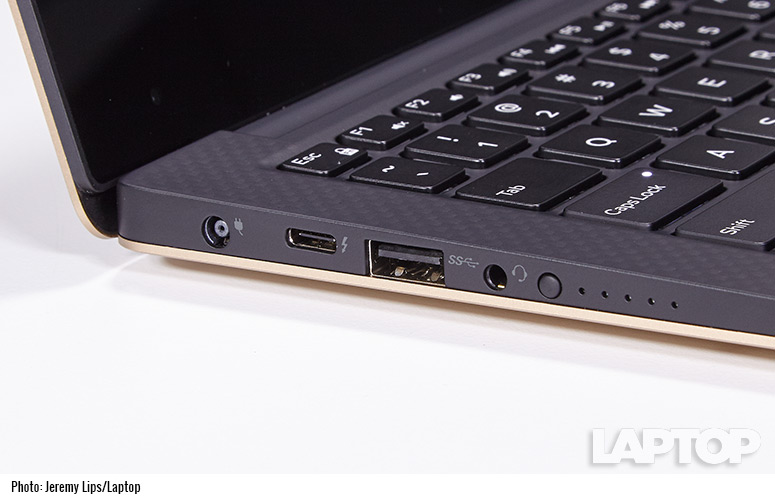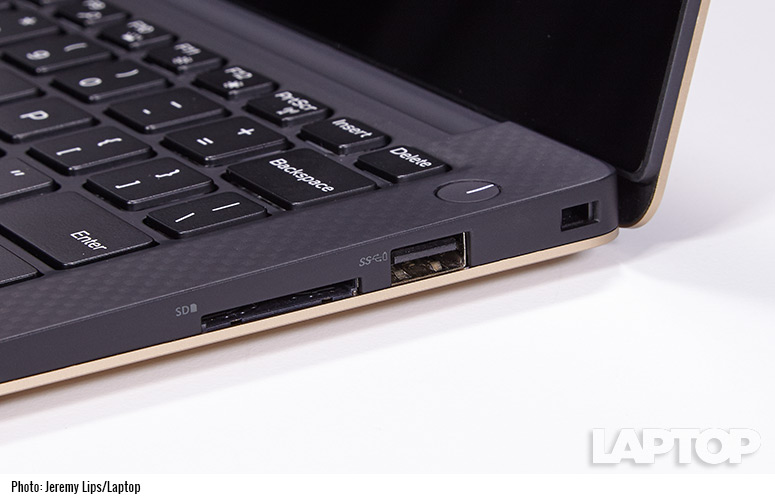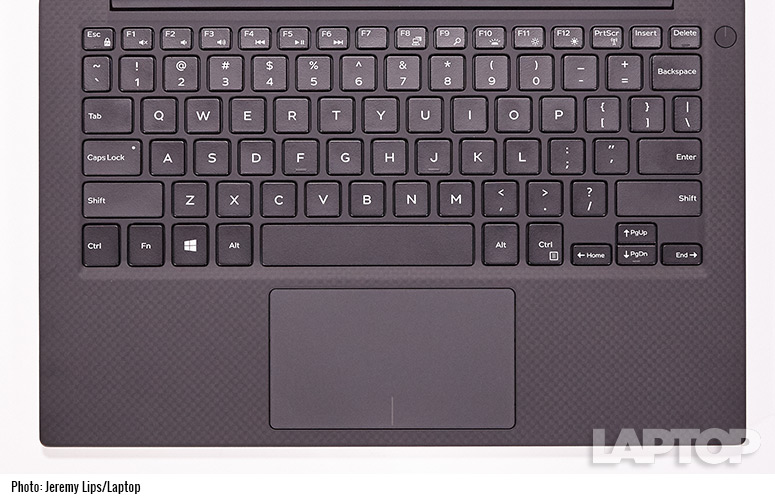Laptop Mag Verdict
The Dell XPS 13 improves upon our top-rated laptop by offering even longer battery life, faster performance and stronger Wi-Fi in an equally compact design.
Pros
- +
Superb battery life
- +
Good 7th-generation Core performance
- +
Excellent Wi-Fi range
- +
More ports than on competing laptops
- +
Comfortable, soft-touch, carbon-fiber deck
- +
Attractive rose-gold color option
Cons
- -
Awkward webcam placement
- -
Not as thin and light as some competitors
Why you can trust Laptop Mag
The Dell XPS 13 became our top overall laptop by offering a 13-inch screen in a more compact package than its competitors, along with a winning combo of design, comfort, performance and battery life. Since its introduction, everyone has been trying to catch this ultraportable, but no one has been able to knock off the champ. Now, Dell has raised the bar even higher with an update to its XPS 13 (starting at $799; $1,099 as tested) that adds the latest 7th-generation Intel Core CPUs (Kaby Lake), even more battery life and stronger Wi-Fi performance.
You can now order this aluminum machine in a fetching rose-gold color, too, if you're willing to pay more for it. The XPS 13 isn't perfect -- see the webcam -- but overall, it remains our top pick.
Design
The XPS 13's most striking feature is its Infinity display, which has almost no bezel around the screen. This is what allows Dell to cram a 13-inch screen into a chassis you'd typically find on an 11-inch notebook. It also makes it look like the screen is floating above the base of the system, allowing you to focus more on your content.
The rest of the laptop is just as attractive as before, even if it's not as thin as some competitors. The top and bottom are made of machined aluminum, which gives the frame a durable and rigid feel. The deck on the inside is even better. It uses a comfortable, soft-touch, carbon-fiber material with a subtle-but-cool checkered pattern, which makes typing a real pleasure.
The soft-touch carbon-fiber deck makes typing a real pleasure.
Between the silver XPS 13 and the rose-gold XPS 13, I'll take the sexier sheen of the rose gold. The silver model is handsome, but the gold version pops, and it's more gold and less pink than the 12-inch MacBook. However, the rose-gold XPS 13 costs $50 more, and it's not available on the Core i3-powered base configuration.
MORE: Best Dell and Alienware Laptops
Sign up to receive The Snapshot, a free special dispatch from Laptop Mag, in your inbox.
Weighing 2.7 pounds for the nontouch model and 2.9 pounds for the touch-screen version, the XPS 13 is lighter than the 3-pound MacBook Air but not as featherweight as the HP Spectre (2.45 pounds) or the 12-inch MacBook (2 pounds). At 0.33 to 0.6 inches, the XPS 13 is also a bit thicker than the Spectre (0.41 inches) and the MacBook (0.5 inches). But you also get more ports on the XPS 13.
The Lenovo Yoga 910, which is a 2-in-1 convertible, weighs 3.04 pounds and measures 12.7 x 8.8 x 0.56 inches, but it packs a larger 13.9-inch screen.
Ports
Unlike skinnier ultraportables, the XPS 13 packs all the ports you need.
You'll find two USB 3.0 ports and an SD card reader, as well as a headphone jack and USB Type-C port with Thunderbolt 3 support. That means you can attach the XPS 13 to two 4K monitors at once. You can also charge the XPS 13 over USB Type-C, though it comes with a proprietary AC adapter.
In comparison, the HP Spectre has three USB Type-C ports, and the 12-inch MacBook has a single USB Type-C port that doesn't support Thunderbolt 3.
Display
You have two display options on the Dell XPS 13, and both of them are pretty great. There's a full-HD, non-touch-screen model with a resolution of 1920 x 1080 and a matte finish. Or, if you want to spend $1,599, there's a quad-HD touch-screen model with a higher resolution of 3200 x 1800 pixels. This glossy panel also offers richer colors, though it's more reflective.
While watching the 4K movie "Tears of Steel" on both XPS 13s, it was clear that the high-res screen was the winner, with far more details in the character's skin and smoother lines in a sniper's scope. In the 1080p trailer for "Wonder Woman," the blue skies of Themyscira were much more vibrant on the touchscreen, as was the red in Diana's outfit. The only issue with the high-res monitor is that it has a bit of glare, so its viewing angles wash out at narrower points than the non-touch version.
Based on our lab tests, the nontouch screen produces a strong 93.6 percent of the sRGB color gamut and the QHD touch version covers 105.7 percent (100 percent or above is great). The nontouch screen is highly accurate with its Delta-E rating of 0.8 (0 is best), but the QHD version is less precise, but much more vibrant, with a score of 4.
MORE: The Best Laptops for Every Need
The HP Spectre hit 100 percent of the gamut and notched a Delta-E of 1.3, and the MacBook delivered 107 percent and 1 on the same tests.
The XPS 13's nontouch panel isn't the brightest, as it reached 302 nits on our testing (the 3200 x 1800 touch display reached 305 nits) That result is above the category average but below the Spectre (359 nits) and the MacBook (327 nits).
Audio
The stereo speakers on the XPS 13 get plenty loud, but the sound gets a little harsh at maximum volume. But that's at the default settings. When I turned up the bass in the Waves MaxxAudio Pro app, Sublime's "What I Got" sounded more balanced. The guitar plucks mixed well with the punchy drum line.
You can make other tweaks, too, such as Reduce Noise and Revive for streaming, and adjusting the Details in tracks with a virtual knob.
Keyboard and Touchpad
The typing experience on the XPS 13 continues to be fairly comfortable. The 1.2 mm of travel is a little less than the HP Spectre's 1.3 mm, but it offered springy feedback. I reached 71 words per minute on the 10fastfingers.com typing test, which is a bit below the 78 wpm I reached on the flatter MacBook keyboard.
Dell's roomy Precision touchpad lived up to its name, offering smooth and precise scrolling. I had no problems executing various gestures, such as swiping with three fingers to switch apps and tapping with three fingers to launch Cortana.
Performance
We reviewed two models of the Dell XPs 13. One came equipped with a 7th-generation Core i5-7200U (Kaby Lake) processor, 8GB of RAM, a 256GB hard drive and 1080p display. The other included a Core i7-7500U CPU, 8GB of RAM, 256GB SSD and a 3200 x 1800 touchscreen. Both sets of components provided swift performance in everyday use and our lab tests, even if the difference between this generation and the last model isn't that substantial.
Even with more than a dozen tabs open, I was able to quickly switch from streaming the trailer for Rogue One: A Star Wars Story, to popping into the Spotify Web Player, to starting a Skype call. The XPS 13 didn't stutter.
On Geekbench 3, which measures overall performance, the Core i5 model scored 7,159 and the Core i7 laptop notched 7,915. Those are solid scores, beating the HP Spectre with a 6th-generation Core i5 (7,026) and blowing past the Core m5-powered MacBook (5,906). The 7th-generation Core i7-powered Lenovo Yoga 910 (7,988) beat both versions of the XPS 13.
MORE: Best Ultrabooks (Thin-and-Light Windows Laptops)
The XPS 13's PCI-e NVMe solid-state drive is pretty speedy, hitting 339.3 megabytes per second. That easily beats the HP Spectre (195.9 MBps) and the Yoga 910 (244.2 MBps) but doesn't quite outpace the MacBook's 355.9 MBps.
The new XPS 13 offers truly epic endurance, lasting 13 hours and 49 minutes on the Laptop Mag web surfing battery test.
You'll have no problem crunching numbers with this ultraportable. The Core i5 XPS 13 took a brisk 3 minutes and 55 seconds (the Core i7 took 3:44) to match 20,000 names and addresses in OpenOffice. The HP Spectre turned in a comparable time to the Dell, and the Yoga 910 (3:34) and MacBook (3:11) were even faster.
Graphics Performance
I was pleasantly surprised to see the XPS 13's Intel HD Graphics 620 card handle the Dirt 3 driving game. With an Xbox controller attached to the laptop, I enjoyed fairly decent frame rates of just over 28 fps on 1920 x 1080 at medium settings.
The XPS 13 also turned in an improved score on 3DMark Fire Strike, notching 916 (927 on Core i7). The Yoga 910 had a comparable score of 915, but the HP Spectre (801) fared worse, with an older Intel 520 graphics card.
Wi-Fi Performance
The Dell XPS 13's Killer 1535 Wireless-AC card, which comes standard on all configurations, is one of my favorite features. In fact, if I had this laptop instead of my 12-inch MacBook when I was working from home, I'd have a much easier time staying connected to my office.
The Dell XPS 13's Killer 1535 Wireless-AC card, which offers excellent range, is one of my favorite features.
To test this card, I placed both the XPS 13 and the MacBook on my desk, upstairs and down the hallway from my router in the living room. The XPS 13 had no trouble loading sites like laptopmag.com and nytimes.com quickly, but the Apple laptop struggled to maintain a connection.
To verify these results, I downloaded the NetSpot program, which surveys wireless networks and measures signal strength. From this same location, the XPS 13 delivered a fairly good 42 percent on the 2.4-GHz band and 23 percent on the 5-GHz band. The MacBook scored just 37 percent and 20 percent, respectively.
Webcam
The biggest weakness of the XPS 13 is its webcam, and it's not because of the picture quality. Because there's no room above the display, Dell placed the camera below the screen, on the left side, right near the hinge. This odd placement results in a very unflattering angle of your chin, as I experienced during a Skype video chat with a colleague.
Also, because the webcam isn't centered, I had to reposition the laptop so I wasn't far off to the right in the frame.
Battery Life
The Dell XPS 13 was already one of the longest-lasting ultraportables on the market, and the new version includes a beefier 60-watt-hour battery -- up from 56 watt hours on the previous model. As a result, the new nontouch version of the XPS 13 offers truly epic endurance, lasting 13 hours and 49 minutes on the Laptop Mag web surfing battery test. (We set all screens at 100 nits of brightness.)
If you really care about battery life, you might want to think twice about the touch screen model. The XPS 13 we tested with a Core i7 CPU and a beefy 3200 x 1800 touchscreen display lasted four and a half hours less, a time of 9:11. Still, that's better than the ultraportable average of 8:05.
MORE: Laptops with the Longest Battery Life
That runtime means the XPS 13 lasted 3 hours longer than the Asus UX306UA (10:44), 4 hours longer than the Apple MacBook (9:38) and more than double the HP Spectre (6:13). The previous nontouch XPS 13 lasted 11:54.
The nontouch XPS 13 lasted 3 hours longer than the Yoga 910 (10:36), 4 hours longer than the Apple MacBook (9:38) and more than double the HP Spectre (6:13). The previous nontouch XPS 13 lasted 11:54.
Heat
The XPS 13 stayed relatively cool to the touch, but the bottom got toasty under pressure. After we streamed a movie for 15 minutes, the touchpad reached just 80 degrees Fahrenheit, the keyboard hit 85 degrees and the bottom was 90 degrees. All of those numbers are below our 95-degree comfort threshold.
However, the underside of the XPS 13 hit 108 degrees after we played a couple of rounds of the Dirt 3 game. I noticed it on my lap, but it wasn't too uncomfortable.
Software
Dell happily keeps the bloat to a minimum on the XPS 13. You'll find McAfee LiveSafe, Dropbox and Microsoft Office, though you have to activate the latter. You'll also find four programmable software titles -- such as Flipboard, Groove Music and Twitter --which are managed by Windows 10 and are part of the standard software load.
Configuration Options
The Dell XPS 13 starts at $799, but we don't think that configuration gives you the most bang for your buck. That model comes with just a 7th-generation Core i3 CPU, 4GB of RAM and a 128GB SSD. We recommend stepping up to a Core i5 processor, 8GB of RAM and 128GB SSD for $999.
If you prefer rose gold to silver, you can step up to that hue for $1,149 and get the same Core i5 chip plus a roomier 256GB SSD. For $1,299, you can get the XPS 13 with a Core i7 processor.
Touch-screen models of the XPS 13 start at $1,399 for the silver color and include a Core i5 CPU, 8GB of RAM and a 256GB SSD. The gold touch-screen version, which has a faster Core i7 chip, goes for $1,649. The top-of-the-line XPS 13 comes in silver with a Core i7, 16GB of RAM and a 512GB SSD.
Bottom Line
The big trend in laptops right now is making your system as thin and light as possible but at the expense of shorter battery life and too few ports. The XPS 13 doesn't cave to that peer pressure, and instead gives you nearly 14 hours of endurance and all the connection options you need in a design that's plenty light and compact for travel. Plus, the new XPS 13 offers a very strong Wi-Fi card, which allowed me to connect in parts of my abode where the 12-inch MacBook barely maintains a signal.
The 7th-generation Core i5 processor and SSD in the XPS 13 offer plenty of speed, and I like that there's enough oomph to play casual 3D games. This ultraportable is also comfortable to use, thanks to its soft-touch deck and accurate touchpad. Yes, the webcam is still in a weird place, but overall, the XPS 13 remains the laptop to beat.
Additional contributions by Andrew E. Freedman
- More on Laptops
- Best 2-in-1s (Laptop/Tablet Hybrids)
- 10 Tablets with the Longest Battery Life
- Best Dell and Alienware Laptops
Dell XPS 13 (2016) Specs
| Bluetooth | Bluetooth 4.1 |
| Brand | Dell |
| CPU | 3.1-GHz Intel Core i5-7200U |
| Company Website | www.dell.com |
| Display Size | 13.3 |
| Graphics Card | Intel HD Graphics 5500 |
| Hard Drive Size | 256GB |
| Hard Drive Speed | n/a |
| Hard Drive Type | SSD |
| Highest Available Resolution | 3200 x 1800 |
| Native Resolution | 1920x1080 |
| Operating System | Windows 10 Home |
| Ports (excluding USB) | USB 3.0, Thunderbolt, SD card slot, Kensington Lock, Headphone |
| RAM | 8GB |
| Size | 11.98 x 7.88 x 0.33-0.6 inches |
| Touchpad Size | 4.1 x 2.3 inches |
| Video Memory | Shared |
| Warranty/Support | one-year limited hardware warranty |
| Weight | 2.7 pounds |
| Wi-Fi | 802.11ac |






